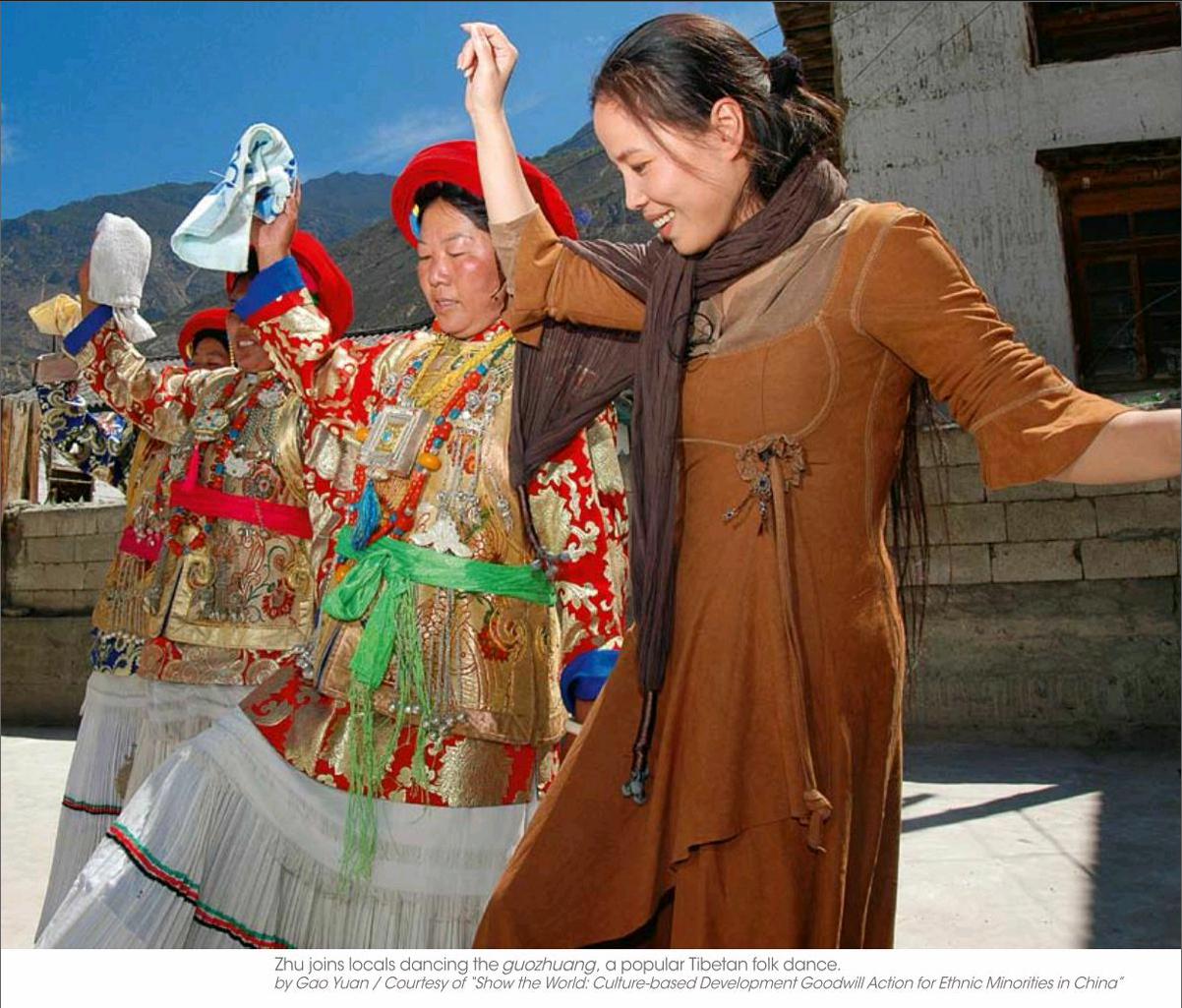Zhu Zheqin:A Modernizing Tradition
by+Zhou+Jin

In January 2014, Chinese singer/song- writer Zhu Zheqin, better known as Dadawa, released the double-CD album Moonrise in Beijing. When Zhu set out on a trip to collect musical samples in 2009, she never expected it to take five years to produce the album.
In the 1990s, Zhu released Sister Drum in 56 countries and regions, the first Chinese album to be released globally, which made her an international artist. The release of Moonrise marked Zhus emergence as a producer.
Ushering Traditional to Modern
During the five years she spent producing the album, Zhu and her team visited ethnic communities in Inner Mongolia, Yunnan, Guizhou, Xinjiang, and Tibet, and collected more than 1,000 music samples during journeys spanning more than 20,000 kilometers.
The target of Zhu and her teams trip was to “recognize and record traditional music passed from mouth to mouth over the past several hundred years in villages.”To fulfill this goal, they traveled deep into villages to explore the beauties of folk art.
In Tingri County, located at the foot of Mt. Everest (Qomolangma), Zhu met Dondrup, an elderly Tibetan practitioner of “blo-gzhas,” a traditional Tibetan folk art combining musical instruments, singing and dancing. “It begins with only one sound, deng, deng, deng… The rhythm is slow, and features subtle changes,” Zhu recalls. Moved by the simple melody, Zhu recorded Dondrups snowy mountain worship song with cutting-edge audio equipment. A year later, she sampled the song from Dondrup in “Mountaintop”and added elements such as an eagle flute, human voices, religion-related percussion, and modern beats. In early 2013, Zhu planned to invite Dondrup to appear in the“Mountaintop” music video, but discovered the old man had already passed away. Dondrups contribution to Zhus song became the mans last worldly performance.
At dusk, on farmland in Guizhou Province, a group of Miao girls sang a song called “The Soul of Rice Flowers.” “After hearing the song only once, it remained clearly in my mind,” she asserts. Zhus“July” was heavily inspired by “The Soul of Rice Flowers.”
Her trip to collect such music samples filled Zhu with a heavy sense of responsibility to carry on ethnic music passed on for so many years. When hearing such tunes, she always feels pressure to contribute to its preservation and survival.
At first, Zhu hoped to help ethnic groups by collecting samples of their folk music and getting international musicians to produce remixed versions. However, her idea changed during the process.
“The biggest motive to collect samples remains to inspire new creation,” remarks Zhu. “They dont delve deep enough to explore possibilities for the cultural genes further development. We need to face our cultural genes, know more about them, and rejuvenate them in order to preserve Chinas ethnic music. We need Chinas ethnic music to be heard by more people in modern times. Only after being accepted by modern society will ethnic music find solid ground for further development.”
Protecting Ethnic Handicrafts
During the process of collecting music samples, Zhu was alerted to the withering of traditional ethnic culture. She called for an“urgent rescue.” In 2009, Zhu became the goodwill ambassador for the United Nations Development Programme (UNDP)s protection plan named “Show the World: Culturebased Development Goodwill Action for Ethnic Minorities in China.”
In 2010, she joined a group of avantgarde designers, artists, and media representatives in a project to visit ethnic group communities and explore the charm of ethnic handicrafts. The team explored delicate ethnic handicrafts in 15 categories including saddles from Inner Mongolia, Tibetan furniture, Guizhou embroidery, Yunnan batik, and Regong thangka from Qinghai.
Zhu was introduced to Nixi black pottery in Deqen Tibetan Autonomous Prefecture of Yunnan Province during her music sample collection trip. The traditional skills to produce Nixi black pottery have been passed on for nearly 2,000 years.
Designers who take part in her project to“explore the charm of ethnic handicrafts”must produce new market-oriented designs with local traditional handicrafts.
Designer Jeff Dah-Yue Shi from Taiwan accepted the task for the black pottery. He and his team conducted indepth research and investigation of Nixi and took four months to produce their“Prosperity?Shangri-La?Wind” series. In it, a “Tashi” teapot set is based on traditional black wine-brewing pottery and teapots, a washbasin takes inspiration from simple and detachable washbasins made of pine, and an LED floor lamp with a black pottery base is inspired by a tool locals use to cut firewood. Nowadays, while many ethnic handiworks are only used as decorations and lose their connections to everyday life, Shis work makes a major breakthrough by combining modern design with traditional handicraft, creating more room for development.
As the organizer and sponsor of the project, Zhu believes that “to protect and promote ethnic cultures, preserving traditional skills and techniques is far from enough.” She insists that more efforts are needed to promote originality and creation, and that people should bid farewell to cheap copies and overexploitation.
Zhu explains that her next major project is to transform ethnic handicrafts into consumable and usable commodities, and to help form a closer relationship between specific industries and their regions, thus creating new industrial patterns and a complete biological chain for ethnic handicrafts. She firmly believes that the next three decades will bring an era of rebuilding “China Spirit” and an age of “created in China.”

